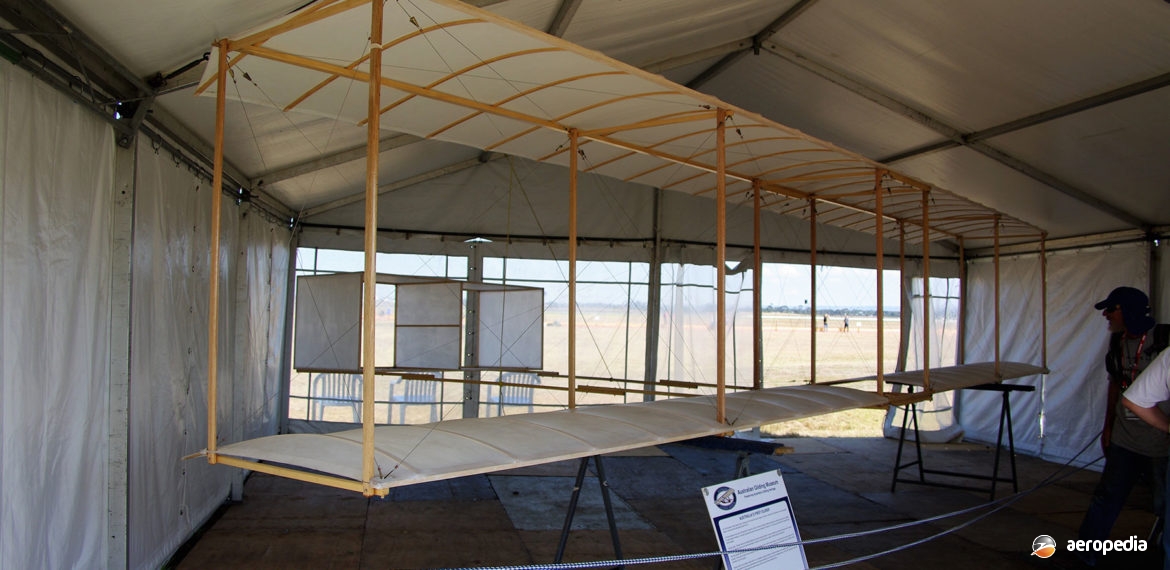Photograph:
Taylor glider replica at the Australian International Airshow at Avalon, VIC in March 2009 (David C Eyre)
Country of origin:
Australia
Description:
Single-engine light aircraft
Power Plant:
One 15.6 kw (21 hp) Gibson & Sons six-cylinder air-cooled engine
Specifications:
- TBA
History:
In the 1890s George Augustine Taylor (1872 – 1928) became interested in aviation and, with the assistance later of Lawrence Hargrave, experimented with gliders. In 1909 he built a glider of his own design, said to be influenced by sketches of designs made by Hargrave. However, it seems whilst Taylor read about the work of Hargrave as a school-boy, and flew kits and models as a youth, he was not directly assisted by Hargrave until 1909.
Little is known about these aircraft, but Mr David Craddock, author of ”Feeling the Air”, has produced working drawings for the Taylor Glider, of which a number of photographs are available. It is only the powered monoplane about which some information has come to light so far. His first un-powered biplane became airborne at Narrabeen Beach on 5 December 1909, and on that day Taylor became the first man in Australia to fly a heavier-than-aircraft. Taylor built a glider, it is said under the auspices of the Australian Army, and later attempted to develop it into a powered aircraft as noted below. It is recorded towards the end of 1909 Taylor was granted a part-time commission in the Australian Army as an intelligence officer with expertise in aeronautics and wireless telephony.
In September 1909 at Surry Hills, NSW, Taylor opened what was claimed to be the first aeroplane manufacturing factory in the southern hemisphere. He built several lifting kites and a powered aeroplane. It is known one airframe, a monoplane, was ready for its engine to be installed at the end of October 1909. It was said at the time it would be the first powered aircraft to fly in Australia. He flew gliders at Narrabeen, NSW, and extolled the virtues of the research that had been carried out by Lawrence Hargrave. He applied himself to powered flight in 1909, was a Fellow of the Royal Geographic Society of London, and was involved in the development of radio telephony for military use. He helped to found the institute of Local Government Engineers of Australia in 1909 and the Town Planning Association of NSW in 1913. He was an associate member of the Wireless Institute of NSW and the Institute of Engineers of Australia. During World War I worked with the Intelligence Section of the General Staff.
One report states Taylor’s monoplane was to be powered by a seven-cylinder radial engine, but it would appear the engine had six cylinders and was designed by Percy Middleton. It used motor-cycle engine cylinders. Middleton was a young engineering student who undertook to supply an engine for the monoplane. He arranged for Gibson & Sons of Balmain, NSW to build it. It was to drive a two-blade aluminium propeller. When the aircraft was complete it was conveyed to the engine manufacturer’s facility at Balmain but the engine was not ready. On completion it was installed but refused to operate and Taylor commenced proceedings against the engine designer.
In the journal ”The Motor in Australia” of 28 October 1909 reference is made to the engine. “Mr Taylor in seeking for a light engine, had no less than four disappointments, but has at last pinned his faith to a new type of engine, having six air-cooled cylinders, working a shaft of one and a half inches diameter. The engine will be of 21 horsepower, but, unfortunately in a sense, it will weigh 5 lb per horsepower.”
The propeller was designed by R F Stowe, a civil engineer.
In November 1909 two of his aircraft, one the glider flown at Narrabeen and the other the powered monoplane, said to look a lot like a Bleriot, were exhibited at the Building Exhibition at Prince Alfred Park in Sydney, NSW.
On 5 December 1909 at Narrabeen Heads, NSW, Taylor flew his glider, as noted above, this being described as being almost identical to a 1907 Voisin glider. An engine built for the glider proved later to be defective.
Two members of the Aerial League, Messrs F Kolta and J G Newman, commenced construction of an aircraft similar to a Bleriot monoplane in a terrace room at Redfern, NSW, in December 1909. It seems by March 1910 Taylor had taken over this project, a report in ”The Motor in Australia” stating Taylor would make “his first flight in a fortnight”. This aircraft was then named The Building Australia and Taylor named his company Aeronautics Supply Co. He offered to sell the aircraft, complete with engine and guarantee to fly, for £300 ($600) and indicated he would carry out trials in March 1910. The aircraft was conveyed to the Randwick Rifle Range, south of Sydney, for this purpose.
In 2007 a replica of Taylor’s glider was under construction in Melbourne, VIC and when completed was placed on display at the Australian International Airshow at Avalon in 2009.

